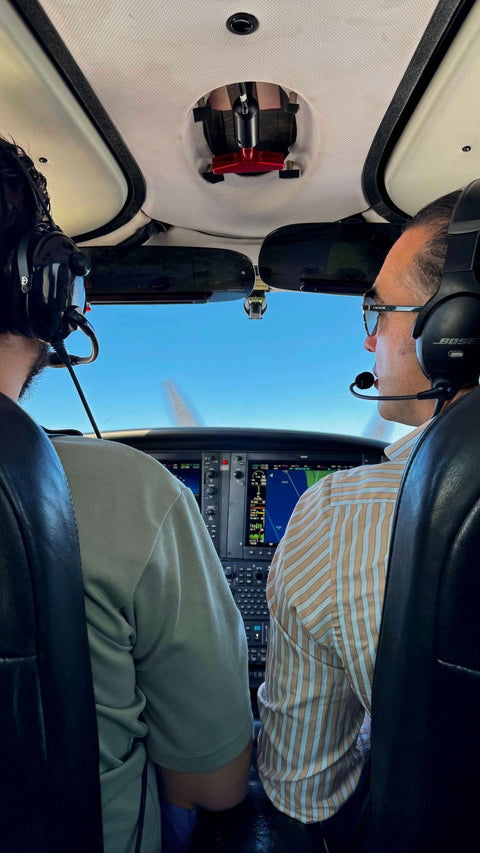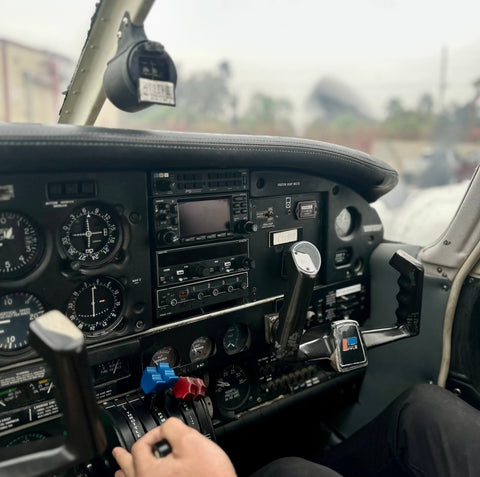Are you dreaming of soaring through the skies and turning your passion for aviation into a career? Choosing the right flight school is a critical first step toward achieving your goals. With so many options available, selecting the best flight school for your needs can feel overwhelming.
In this guide, we’ll walk you through the key factors to consider when choosing a flight school so you can make an informed decision that sets you up for success.
Define Your Aviation Goals: Private Pilot License
Before you start looking at flight schools, ask yourself: What do you want to achieve? Are you pursuing aviation as a career or a hobby? Do you want to become a pilot? Understanding your goals will help you narrow down your options.
-
Recreational Flying: If you’re learning to fly for personal enjoyment, you may not need an intense training program. A smaller, local flight school may be ideal, offering flexible scheduling and cost-effective training.
-
Professional Pilot Career: If your goal is to become a commercial pilot, you’ll need a structured program that includes Private Pilot License (PPL), Instrument Rating (IR), Commercial Pilot License (CPL), and possibly a Certified Flight Instructor (CFI) rating. Many aspiring airline pilots also pursue a Multi-Engine Rating (ME) and Airline Transport Pilot License (ATPL) for career advancement.
-
Airline Pathway Programs: Some schools partner with airlines, offering fast-track programs that prepare you for airline careers. These programs often include job placement assistance and airline mentorships, providing a direct path to employment.
Knowing your goals ensures you choose a school that aligns with your aspirations and maximizes your investment in flight training.
Consider the Cost of Flight Training
Flight training is an investment, and costs can vary widely depending on location, aircraft type, and program structure. Be sure to factor in:
-
Tuition and Hourly Flight Costs – Some schools charge per flight hour, while others offer all-inclusive programs with fixed pricing.
-
Exam and Licensing Fees – FAA checkride and written exam fees add to the total cost.
-
Additional Expenses – Books, headsets, uniforms, insurance, and housing (if applicable) should be included in your budget.
-
Financing Options – Many schools offer student loans, scholarships, or financing plans to ease the financial burden. Research government-sponsored funding options, veteran benefits, or employer-sponsored tuition assistance programs.
Becoming an airline pilot involves significant financial planning, including considering loans for flight school and understanding the current job market for airline pilots.
While affordability is important, the cheapest option isn’t always the best. Investing in a reputable program with well-maintained aircraft, experienced instructors, and solid career placement support can lead to better training and job opportunities.
Time Commitment: Full-Time vs. Part-Time Training
Flight training programs require a significant time commitment. Consider your schedule when selecting pilot training programs:
-
Full-Time Training: Accelerated programs can get you licensed in a few months, ideal if you want to start your aviation career quickly. These programs often follow a structured curriculum, helping you reach airline hiring minimums faster.
-
Part-Time Training: More flexible but takes longer. Suitable for those balancing work, school, or family commitments. However, inconsistent training can slow progress and require additional review sessions, increasing costs.
Consistent flying is crucial for skill retention, so make sure your chosen schedule allows you to train regularly to build muscle memory and confidence in the cockpit.
Part 61 vs. Part 141 Flight Schools
Flight schools operate under two sets of FAA regulations:
-
Part 61: Offers flexibility, allowing students to complete training at their own pace. Ideal for those needing a customized schedule or who learn best in a self-paced environment.
-
Part 141: Follows a structured syllabus approved by the FAA. Best for students looking for an accelerated, disciplined training path. Part 141 programs require fewer flight hours to meet certification requirements, which can save time and money.
High-quality flight instruction is crucial for aspiring pilots. Experienced instructors provide exceptional training, creating a supportive and effective learning environment.
If you’re aiming for a career in commercial aviation, a Part 141 school may be more beneficial due to its structured approach and reduced flight-hour requirements for certain certifications.
Fleet, FAA Approved Flight Simulators, and Aircraft Maintenance
The type and condition of aircraft used for training can significantly impact your learning experience.
-
Newer vs. Older Aircraft: Modern glass cockpit aircraft offer advanced avionics, making transitions to airline aircraft smoother. Traditional analog gauge aircraft, while less technologically advanced, can be more affordable for training.
-
Fleet Size: A larger fleet reduces scheduling delays and increases training efficiency. Schools with a diverse fleet allow students to train in different aircraft types, better preparing them for various flying conditions.
-
Maintenance Standards: Schools should have well-maintained aircraft with a dedicated maintenance team to ensure safety. Ask about their maintenance records, frequency of inspections, and aircraft availability.
Always visit the school to inspect the fleet and ask about maintenance policies to ensure safety and reliability.
FAA Approved Flight Simulators and Programs
When it comes to flight training, having access to FAA-approved flight simulators can make a significant difference in your learning experience. At Essence Flight Academy, we utilize state-of-the-art simulators that provide a realistic and immersive environment for our students. These simulators are equipped with advanced technology, including touch-screen navigation and realistic weather conditions, allowing you to practice a variety of scenarios, from instrument meteorological conditions (IMC) to emergency procedures.
Using FAA-approved flight simulators is an integral part of our training program. They offer a safe and controlled environment where you can hone your skills before taking to the skies. Additionally, simulators help reduce the overall cost of flight training, as you can practice maneuvers and procedures without the expense of actual flight time. This combination of realism, safety, and cost-effectiveness makes our simulators an invaluable tool in your journey to becoming a proficient pilot.
Instructor Experience and Availability
Your flight instructor plays a huge role in your training. Look for schools with experienced instructors who are passionate about teaching.
-
Student-to-Instructor Ratio: A lower ratio means more personalized instruction, ensuring you receive quality training and timely feedback.
-
Instructor Experience: High instructor turnover can disrupt training consistency. Look for schools with stable, experienced flight instructors who have real-world aviation experience.
-
Instructor Availability: Ensure instructors are accessible for scheduled lessons and flexible with additional training needs. Some schools have limited instructor availability, causing delays in flight training progression.
A great instructor makes a significant difference in your confidence, learning experience, and ability to pass checkrides.
Discovery Flight and Trial Lessons
If you’re curious about what it’s like to fly an aircraft, Essence Flight Academy offers discovery flights and trial lessons that provide a hands-on introduction to aviation. These experiences allow you to take the controls and fly an aircraft under the guidance of our experienced and certified flight instructors. It’s a thrilling opportunity to get a taste of what being a pilot is all about.
Discovery flights and trial lessons are designed to help you determine if a career in aviation is right for you. During these sessions, you’ll receive personalized instruction and guidance, giving you a glimpse into the world of aviation and the training process. Whether you’re considering a private pilot license or aiming for a commercial pilot career, these introductory flights are a great way to start your journey and experience the excitement of flying firsthand.
Location and Weather Conditions
The school’s location can impact your training timeline.
-
Busy vs. Uncontrolled Airspace: Training at a busy airport prepares you for real-world flying conditions, improving your communication skills and situational awareness. On the other hand, quieter airspace allows for more uninterrupted flight time, making training more efficient.
-
Weather Conditions: Areas with fewer weather delays provide consistent flying opportunities, helping you complete training faster. Locations with predictable weather, such as Southern California, Florida, and Arizona, are ideal for year-round flying.
-
Cost of Living: If relocating, consider housing, transportation, and daily expenses. Some flight schools offer student housing or recommend affordable accommodations nearby.
Choose a location that fits your lifestyle, budget, and training needs to ensure a smooth and efficient training experience.
Busiest General Aviation Airports
Training at one of the busiest general aviation airports, such as Van Nuys Airport (VNY), offers unique advantages for aspiring pilots. VNY is a hub for flight training and education, with numerous flight schools and academies located on the field. The airport’s busy environment provides a realistic and challenging training experience, preparing you for the demands of flying in both commercial and private settings.
Van Nuys Airport’s proximity to Los Angeles and the San Fernando Valley makes it an ideal location for flight training. You’ll have the opportunity to train in a wide range of airspace and weather conditions, enhancing your skills and situational awareness. The bustling environment also allows you to practice various scenarios, including takeoffs and landings, taxiing, and emergency procedures, ensuring you’re well-prepared for real-world flying.
Flight Academy Facilities and Equipment
Essence Flight Academy, located at Van Nuys Airport (VNY), boasts state-of-the-art facilities designed to provide a comprehensive and supportive learning environment. Our academy features modern classrooms, briefing rooms, and flight planning areas, all equipped with the latest technology to enhance your training experience.
Our fleet includes a variety of modern and well-maintained aircraft, such as Cirrus, Cessna, Diamond, and Piper models. These aircraft are equipped with advanced technology, including touch-screen navigation and realistic weather systems, ensuring you receive top-notch training. Additionally, our academy offers a range of flight training equipment, including flight simulators, flight planning software, and weather radar systems.
At Essence Flight Academy, our facilities and equipment are tailored to help you achieve your aviation goals. Whether you’re pursuing a private pilot license or aiming for a commercial pilot career, our state-of-the-art resources provide a safe and effective training environment, setting you up for success in the world of aviation.
Reviews and Reputation
Researching a flight school’s reputation is crucial. Look for:
-
Student Reviews: Check testimonials on Google, social media, and aviation forums to learn about other students’ experiences.
-
Graduate Success Stories: Do former students get hired at airlines or continue in aviation careers? High job placement rates indicate a strong program.
-
Accreditations and Partnerships: Schools affiliated with major airlines or aviation organizations often provide better training and career support.
A well-respected school increases your chances of landing a good job after graduation.
Accreditation and FAA Certification
Accreditation ensures a flight school meets high training and safety standards. Look for schools approved by:
-
FAA (Federal Aviation Administration)
-
National Association of Flight Schools (NAFS)
-
Airline Transport Pilot (ATP) Programs
An accredited school enhances your resume and opens doors for airline interviews and career opportunities.
Career Placement Assistance
If you’re pursuing aviation as a career, job placement support is a valuable resource.
-
Airline Partnerships: Some schools have direct hiring pathways with regional airlines, ensuring a seamless transition into the workforce.
-
Internships & Networking: Schools with industry connections can help you build relationships with potential employers, flight instructors, and airline recruiters.
-
Mentorship Programs: Guidance from experienced pilots can accelerate your career growth, helping you navigate the path to becoming a professional pilot.
A school with strong career placement services sets you up for success beyond training.
Ready to Begin Your Flight Training?
Choosing the right flight school is a big decision, but with careful research, you can find the perfect fit for your aviation goals.
At LA Flight School, we offer comprehensive training programs tailored to aspiring pilots. Whether you’re looking for private pilot training or a full commercial pathway, we provide high-quality instruction, modern aircraft, and career support to help you achieve your dreams.
Ready to take the next step? Contact us today to schedule a consultation and discovery flight!



